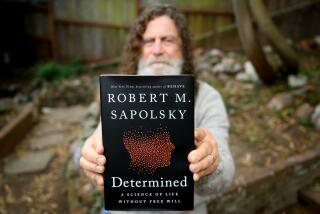The softer side of decision-making
Honey Nut Cheerios or regular Cheerios. The Caribbean or Hawaii. To be human is to be endlessly jostled by choice. Decisions are earnest business. How should we make them?
Philosophers such as Plato and Descartes thought it best if pure reason decided everything. The heirs of Socrates pictured the passions as intoxicants interfering with our ability to think clearly. It was not until Soren Kierkegaard that some philosophers acknowledged that there is a cognitive dimension to emotion, and later, that reason and emotion may not be entirely separate agencies. In his latest offering, “How We Decide,” Jonah Lehrer explores the nexus of thought and feeling in the decision-making process.
Lehrer begins by debunking the notion that we should all make our decisions like hyper-rational Mr. Spock. Lehrer, who also wrote “Proust Was a Neuroscientist,” observes that perfectly intelligent people become virtually unable to make the most trivial decisions when their capacity for feelings are flattened as a result of brain disease or trauma. This is no surprise. Emotions inject our mental representations with direction and intensity.
Lehrer maintains that there are many cases in which the unfeeling intellect is simply doltish. Pondering the split-second judgments of quarterbacks, pilots and firefighters, Lehrer shows that if conscious reason were all we had, it would be impossible to make solid nanosecond decisions.
Lehrer recounts one of the book’s riveting stories. In the heat of the Persian Gulf War, Royal Navy Lt. Cmdr. Michael Riley was manning a shipboard radar station when he picked up a blip showing something heading toward the Missouri. The projectile had the profile of both an incoming coalition A-6 aircraft and an enemy Silkworm missile. Riley had no criteria for deciding between the two and was tortuously suspended between the possibilities of allowing a strike and blasting his brothers-in-arms out of the sky. But, Riley said, “There was something strange about this radar blip. It didn’t feel like an A-6.”
On gut feeling, Riley gave the order to shoot down what turned out to be an enemy missile. After hours of analysis, the officer and a cognitive psychologist resolved that his feeling was a subliminal recognition that the missile entered his screen at a slightly different interval from the planes he was used to tracking.
Lest the reader confuse the conclusions of this work with those of Malcolm Gladwell’s “Blink,” Lehrer acknowledges that Plato was not entirely wrong. Feelings can becloud our natural lights. Our emotions, via the neurotransmitter dopamine, help us find patterns. When something out of the ordinary occurs, feelings tell you to cram the new situation into the old paradigm. That can be a fatal mistake.
In 1989, United Airlines Capt. Al Haynes accomplished the seemingly impossible task of crash landing a DC-10 without a hydraulic system. Haynes recalled many points in his white-knuckle descent when instinct would have pulled him into a deadly tailspin.
Lehrer goes further than just parsing the rational and emotional dimensions of judgment. He looks to uncover the mechanisms beneath the hood. As such, he relies heavily on brain-imaging studies. Many scientific brows have been raised about conclusions drawn from this method of investigation, but as the true believers have it, if a part of your brain lights up when you are, say, angry, then that area is the seat of anger.
By book’s end, you feel as though every internal dialogue is a battle between precincts of gray matter. Lehrer is so invested in his neurological topography that he often writes as if the mind were a village of homunculi. “If someone is thinking about a math problem . . . then her prefrontal neurons are thinking about that problem.” Personifying parts of the brain is a misleading way of talking about the mind.
Lehrer’s beliefs about the brain sometimes outrun his data, but one view he shares with philosophers is that we humans are strongly predisposed to pulling the wool over our own eyes. A central tenet of “How We Decide” is that by knowing how our minds work, we will be better able to use our noodles. Accordingly, we need to understand that the brain craves the quietude of certainty. Doubts are unpleasant turbulence to brains barreling toward conclusions. In admirable earnestness, the twentysomething author admonishes that if we want to improve our decision-making IQs, we need to make an effort to nurture our inner skeptics. If the reader obeys that advice, he will relish and learn from this substantive and elegantly written book.
--
Marino, a philosophy professor at St. Olaf College, is editor of the forthcoming “Ethics: The Essential Writings.”
More to Read
Sign up for our Book Club newsletter
Get the latest news, events and more from the Los Angeles Times Book Club, and help us get L.A. reading and talking.
You may occasionally receive promotional content from the Los Angeles Times.








